

Aside from its visual appeal, eucalyptus is a tree credited with many benefits and uses.
Key Eucalyptus facts
Name – Eucalyptus
Family – Myrtaceae
Type – tree
Height – 32 to 130 feet (10 to 40 m)
Climate – temperate to warm
Exposure – full sun
Soil – ordinary, well drained – Foliage – evergreen
Hardiness – 26°F (-3°C) to 0°F (-18°C) depending on the variety
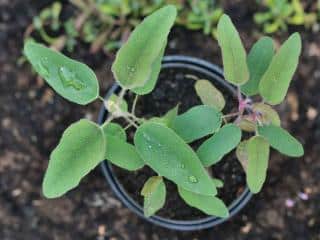 Eucalyptus is a tree that is best planted in fall or at the beginning of spring.
Eucalyptus is a tree that is best planted in fall or at the beginning of spring.
It grows fast and it doesn’t require any particular care.
Proper mulch will avoid having weeds proliferate around the trunk and will protect the root system when winters are cold, especially during the first few years.
 Eucalyptus care is very easy because it requires practically no attention at all once it has settled in comfortably.
Eucalyptus care is very easy because it requires practically no attention at all once it has settled in comfortably.
Pretty hardy, eucalyptus has no known common disease. It sometimes is attacked by psyllids.
However, it is at times vulnerable to the cold. Most varieties cannot survive when temperatures drop below 23°F (-5°C).
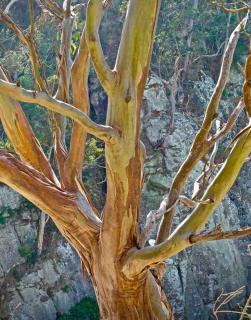 No pruning is necessary, but if you must reduce or balance the branches out, act in spring or end of summer. Abundant sap makes for quick wound-closing and healing.
No pruning is necessary, but if you must reduce or balance the branches out, act in spring or end of summer. Abundant sap makes for quick wound-closing and healing.
Eucalyptus trees have many dormant buds under their bark. These sprout into epicormic shoots – simple branches, actually – whenever the canopy is pruned or damaged. This is how Eucalyptus survives and bounces back after burning in forest fires!
One way of not having side shoots is to plant shrubbery around to reduce light falling on the trunk.
Eucalyptus is very vigorous. Whenever growing conditions are optimal, it will send shoots up from its roots. These are called root suckers.
Here is how to deal with eucalyptus root suckers:
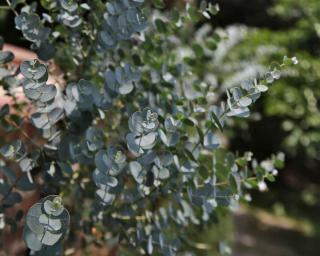 Snip them off as soon as you see them. Mowing the lawn usually does the trick.
Snip them off as soon as you see them. Mowing the lawn usually does the trick.If digging roots out, once you’ve cut the root coming from the mother tree, let the wound “cure”. This means to let it dry in shaded air for a couple hours before filling the hole back in.
There’s no permanent solution to keep the eucalyptus from sending shoots up. As a consequence, go around the garden with pruning shears every once and a while as part of your regular garden routine!
 Native to Australia, Eucalyptus is a member of the Myrtaceae family. Although the geographical point of origin is on the other side of the world, Eucalyptus radiata or narrow-leaved peppermint has adapted to many climates in the western hemisphere, together with other eucalyptus species such as E. gunnii, E. niphophilia or E. globulus.
Native to Australia, Eucalyptus is a member of the Myrtaceae family. Although the geographical point of origin is on the other side of the world, Eucalyptus radiata or narrow-leaved peppermint has adapted to many climates in the western hemisphere, together with other eucalyptus species such as E. gunnii, E. niphophilia or E. globulus.
Eucalyptus is a tree that now grows in many regions of the planet. Many countries in Europe, Latin America, Africa, Madagascar or the Middle East make use of it in gardens and parks.
It bears beautiful leaves that are easy to recognize thanks to their silvery shimmering in the light. Seeing that, the eye is drawn to the trunk, which peels in colorful layers that meld silver, brown and green.
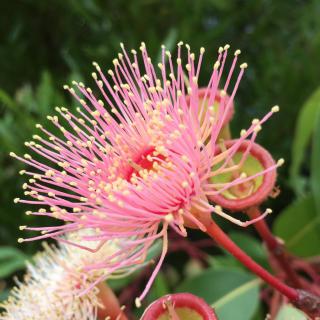 Blooming is only possible in warm climates for this tree native to Australia and Tasmania.
Blooming is only possible in warm climates for this tree native to Australia and Tasmania.
In those countries, the blooming provides excellent nectar for honey.
Dots on each leaf are actually oil glands. These are great for eucalyptus essential oil.
Eucalyptus flavor even appears in mint-flavored chewing gum and in cough drops!
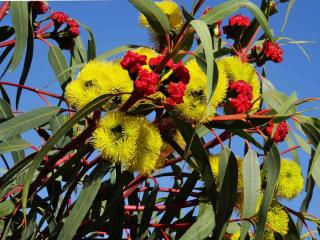 Here are some types of eucalyptus that are appealing for their beauty, size, hardiness or medicinal properties.
Here are some types of eucalyptus that are appealing for their beauty, size, hardiness or medicinal properties.
Plant this tree in a wide open space, because it quickly grows dozens of yards or meters high.
We had a very cold december in South Carolina and my eucalyptus tree leaves all turned brown. The tree is only a year old. Is this normal for this type of type go dormnent ?
Hello Paul, not all Eucalyptus species are the same. For most of them, a young tree subject to frost would very certainly lose its leaves and go dormant. Hopefully the cold wasn’t deep enough to kill the tree outright. If there’s a risk that it might freeze hard again, as it very well might until end of Feb in South Carolina, you might want to look into winterizing the young tree – protecting it in winterizing fleece. It’s a type of cloth that lets air through but still insulates very well against the cold.
hello. i’m looking to add this in my agroforestry system… as a chop and drop tree. do you think this will respond well? i live in the Philippines, these trees are native here.
We topped an older 50 foot high eucalyptus radiata tree. We now have a bushier upper part of the tree but also have multiple groups of shoots coming out of the sides of the tree and at the base of the tree. I’ve just been cutting the ones back to the bark on the area I don’t want these shoots. But they keep sprouting in the same areas. Will they eventually stop growing there if I keep cutting them back?
Hi! What triggers the sprouting there is light and the reduced activity at the top of the tree. Since the tree was topped, the trunk is now exposed. Sprouting should diminish as the canopy higher up builds up. You can also try planting shrubs around your tree, this would also block light out. Eucalyptus do this really often, it’s one of their survival strategies to recover from fires. Cutting them back in itself won’t stop the sprouting, but it’ll help shape the tree the way you want it to grow.
This information does not tackle the problem of neglected eucalyptus which have smaller trees growing from their roots to a considerable height. Is it all right to cut them at the base which would then leave the original tree looking much better and with more space ?
Hello Stella, thanks for your question. It’s perfectly all right to cut side shoots off. You’ll need to keep watch over the stump for a while because it’ll want to send shoots up for a while after that. You’re right that a single large tree sometimes looks much nicer!